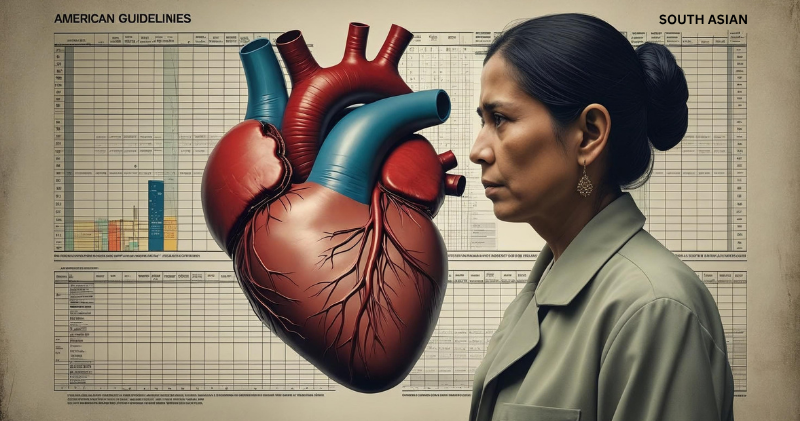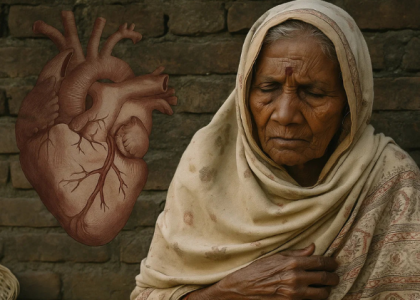Your blood test results come back marked “normal” across the board. Your doctor smiles and says, “Keep doing whatever you’re doing—your cholesterol looks great!” But as you walk out of the office, a nagging worry follows you home. Your uncle had a heart attack at 49. Your father developed diabetes at 45 despite never being overweight. Your grandmother had bypass surgery at 62.
If your family history reads like a cardiology textbook, why is your doctor so reassuring about numbers that seem fine for everyone else but somehow don’t feel right for your family’s pattern?
The uncomfortable truth is that American cardiovascular guidelines—the standards your doctor uses to assess your heart risk—were built primarily on data from white populations and may be systematically missing the early warning signs that could save South Asian lives. While these guidelines work reasonably well for the populations they were designed around, they’re leaving our community vulnerable to preventable heart attacks, strokes, and diabetes complications.
It’s time to rethink how we assess heart risk in South Asians. Not next year, not after more studies—now, while there’s still time to prevent the next generation of “surprising” diagnoses in our families.
The Problem: A One-Size-Fits-All System
American medicine prides itself on evidence-based care, but there’s a hidden assumption in that evidence: what works for the majority of study participants will work for everyone. The problem is that the majority of participants in landmark cardiovascular studies have been white, male, and middle-aged, creating guidelines that may not accurately predict risk in South Asian populations.
The Framingham Foundation: Most cardiovascular risk assessment in the U.S. stems from the Framingham Heart Study, which began in 1948 and followed predominantly white residents of Framingham, Massachusetts. While this research revolutionized our understanding of heart disease, it created risk calculators based on how cardiovascular disease develops in European populations.
Current U.S. Guidelines Miss South Asian Realities:
The American Heart Association and U.S. Preventive Services Task Force recommend:
- Cholesterol screening beginning at age 40-45 for men, 50-55 for women
- Using standard BMI cutoffs (25 for overweight, 30 for obesity)
- Focusing primarily on LDL cholesterol levels
- Using the ASCVD (Atherosclerotic Cardiovascular Disease) Risk Calculator based on traditional risk factors
Why This Fails South Asians:
These guidelines ignore critical differences in how cardiovascular disease develops in our population:
Early Onset Disease: South Asians develop heart disease 5-10 years earlier than other populations, meaning screening that starts at 40-45 often misses the window for primary prevention¹. By the time standard guidelines recommend testing, damage may already be accumulating.
Different Body Composition: The BMI categories that define obesity in guidelines (BMI over 30) miss the reality that South Asians develop metabolic complications at much lower weights. Research shows we can have dangerous levels of visceral fat with BMIs as low as 22-23².
Unique Lipid Profiles: Standard cholesterol panels often miss the lipid abnormalities most common in South Asians. We’re more likely to have:
- High triglycerides with normal or low LDL cholesterol
- Low HDL cholesterol despite vegetarian diets
- Elevated small, dense LDL particles not captured by basic testing
- High Lp(a) levels (a genetic cholesterol variant affecting up to 30% of South Asians)
Insulin Resistance at Normal Weight: Current guidelines assume diabetes screening can wait until BMI reaches overweight ranges. For South Asians, this misses the “skinny diabetic” phenomenon where insulin resistance develops at normal weights.
According to research published in the Journal of the American College of Cardiology, traditional risk calculators underestimate cardiovascular risk in South Asian populations by as much as 30-50%³. This means thousands of South Asians are walking around with significant heart disease risk that their doctors don’t recognize using standard assessment tools.
Why It’s Dangerous for South Asians
This mismatch between guidelines and South Asian physiology isn’t just an academic problem—it’s contributing to preventable heart attacks and deaths in our community every day.
The Early Heart Attack Crisis: Data from the INTERHEART study shows that South Asians have their first heart attacks an average of 10 years earlier than other populations⁴. Men in their 40s and women in their 50s are having “premature” heart attacks that might have been prevented with earlier screening and intervention.
Silent Disease Progression: Many South Asians develop what cardiologists call “silent” cardiovascular disease—plaque buildup and arterial damage that progresses without obvious symptoms. Because standard risk assessment misses our unique risk factors, this silent disease often goes undetected until it’s advanced enough to cause heart attacks or strokes.
The Normal Weight Diabetes Trap: Current guidelines focus diabetes screening on overweight individuals, missing the reality that South Asians can develop Type 2 diabetes at BMIs of 22-25. The CDC estimates that 40% of South Asian diabetics in the U.S. have normal BMIs and might not meet standard screening criteria⁵.
Lipid Testing Gaps: Standard cholesterol tests focus on LDL and total cholesterol levels that may appear normal in South Asians while missing the triglyceride elevation, low HDL, and high Lp(a) levels that actually drive our cardiovascular risk. Patients receive false reassurance about cardiovascular health while dangerous lipid patterns go unaddressed.
Family History Dismissed: When South Asian patients mention extensive family histories of early heart disease, doctors using standard risk calculators may still classify them as “low risk” if their current numbers look normal by Western standards. This dismisses the powerful genetic and cultural risk factors that compound over generations.
The result is a healthcare system that systematically underestimates South Asian cardiovascular risk, leading to delayed diagnosis, missed prevention opportunities, and more advanced disease at the time of first detection.
What Needs to Change
Reforming cardiovascular care for South Asians requires changes at multiple levels—from individual doctor education to national guideline revisions. Here’s what needs to happen:
Guideline Reforms:
Earlier Screening Protocols: Professional medical organizations should recommend cardiovascular screening for South Asians beginning in their late 20s or early 30s, especially with any family history of early heart disease or diabetes.
Ethnicity-Specific Risk Calculators: The American Heart Association should develop and validate risk assessment tools that account for South Asian genetic predispositions, different body composition patterns, and unique lipid profiles.
Updated BMI Thresholds: Guidelines should recognize that South Asians develop metabolic complications at lower BMI cutoffs—perhaps 23 for overweight and 25 for obesity rather than the current 25 and 30.
Comprehensive Lipid Testing: Standard cholesterol panels should include ApoB, Lp(a), and triglyceride/HDL ratios for South Asian patients, not just LDL and total cholesterol.
Clinical Practice Changes:
Expanded Testing Protocols: Primary care doctors should routinely order:
- ApoB levels (more predictive than LDL for South Asians)
- Lp(a) testing (elevated in 20-30% of South Asians)
- HbA1c testing regardless of BMI for patients over 30
- Waist-to-hip ratio measurements rather than relying solely on BMI
Cultural Competency Training: Medical schools and residency programs should include specific education about South Asian cardiovascular risk factors, dietary patterns, and cultural considerations that affect health outcomes.
Family History Weighting: Risk assessment should place greater emphasis on family history patterns in South Asian patients, recognizing that genetic factors play a larger role in our population.
Research Priorities:
Inclusive Clinical Trials: Pharmaceutical companies and research institutions should ensure adequate South Asian representation in cardiovascular trials, particularly for lipid-lowering medications and diabetes prevention interventions.
Population-Specific Studies: The NIH should fund large-scale studies specifically examining cardiovascular disease development in South Asian populations living in Western countries.
Cultural Adaptation Research: Studies should examine how traditional South Asian dietary patterns can be optimized for cardiovascular health while maintaining cultural authenticity.
What You Can Do Right Now
While we work toward systemic change, you can’t wait for guidelines to catch up with your genetic reality. Here’s how to advocate for appropriate care within the current system—including navigating the insurance and physician resistance you’ll likely encounter:
Before Your Next Doctor Visit:
Prepare Your Family History: Create a detailed record of heart disease, diabetes, and stroke in your family, including ages at diagnosis. Present this as a written summary rather than just mentioning it verbally.
Know What to Request: Specifically ask your doctor for:
- ApoB testing (“I’d like to know my actual cholesterol particle number”)
- Lp(a) levels (“This is a genetic cholesterol factor that’s common in South Asians”)
- HbA1c testing (“I want to check for diabetes risk even though my weight is normal”)
- Advanced lipid panel (“I need triglycerides and HDL, not just LDL”)
- Waist-to-hip ratio (“This is more accurate than BMI for my ethnic background”)
Use Self-Assessment Tools: Complete comprehensive risk assessments like the one on SouthAsianHeart.com before your appointment. Bring the results to show your doctor areas of concern that standard screening might miss.
Overcoming Doctor Resistance:
When Your Doctor Says “You Don’t Need These Tests”: Many physicians stick strictly to standard guidelines and may resist ordering tests they consider “unnecessary.” Here’s how to respond:
- Use Medical Language: Say, “Given my South Asian ethnicity and family history, I’m at higher risk for early cardiovascular disease. Can you document in my chart that I requested ApoB and Lp(a) testing and your clinical reasoning for declining?”
- Reference Research: Mention specific studies: “The INTERHEART study shows South Asians have different risk patterns. I’d like screening that reflects this evidence.”
- Request Documentation: Ask your doctor to note in your medical record that you requested specific tests and their reasons for declining. This often motivates reconsideration.
- Seek Second Opinions: If your doctor remains resistant, ask for a referral to a cardiologist or find a physician more familiar with ethnic health disparities.
Navigating Insurance Barriers:
The Insurance Coverage Challenge: Even when doctors agree to order appropriate tests, insurance companies often deny coverage for “preventive” testing that falls outside standard guidelines. Here’s your strategy:
Pre-Authorization Tactics:
- Use Diagnostic Codes: Ask your doctor to use family history codes (Z87.891 for family history of cardiovascular disease) to justify testing
- Document Symptoms: Mention any symptoms like fatigue, chest tightness, or shortness of breath that could justify diagnostic rather than screening codes
- Appeal with Evidence: If initially denied, submit appeals citing South Asian-specific research and family history
Cost-Effective Alternatives:
- Direct-Pay Labs: Companies like Quest Diagnostics and LabCorp offer direct-pay options for ApoB ($40-60) and Lp(a) ($50-80) testing
- Health Savings Accounts: Use HSA/FSA funds for out-of-pocket testing costs
- Annual Physicals: Some tests may be covered as part of comprehensive annual exams—timing matters
Insurance Appeal Language: When appealing denials, use phrases like:
- “Medically necessary due to ethnic-specific risk factors”
- “Family history indicates genetic predisposition requiring advanced screening”
- “Standard testing inadequate for South Asian cardiovascular risk assessment”
Effective Communication Strategies:
Reference Medical Literature: Mention that you’ve read about South Asian-specific cardiovascular risks and would like more comprehensive screening. Doctors are more likely to take requests seriously when patients demonstrate medical knowledge.
Frame It as Prevention: Say, “I want to be proactive about prevention given my family history and ethnic background” rather than “I think something is wrong.”
Ask for Referrals: If your primary care doctor seems unfamiliar with South Asian risk factors, ask for a referral to a cardiologist or endocrinologist who has experience with diverse populations.
Document Everything: Keep records of what tests you’ve requested, what your doctor has said, and what results you’ve received. This helps track patterns over time and ensures continuity if you change providers.
Build Community Awareness:
Share Information: Use social media and family networks to spread awareness about South Asian-specific health risks. Many people in our community don’t know that standard guidelines may not apply to them.
Support Research: Participate in health studies that include South Asian populations. Community participation in research is essential for developing better guidelines.
Advocate Collectively: Join or support organizations working to improve health equity and cultural competency in healthcare.
It’s Time to Stop Being Invisible in American Medicine
For too long, South Asians have been medically invisible—present in American healthcare but absent from the research and guidelines that determine our care. We’ve accepted “normal” test results while watching our family members develop preventable diseases. We’ve trusted a system that wasn’t designed with our bodies and genetics in mind.
But invisibility is a choice, and it’s time to choose visibility.
The power to change this lies partly with us: When we walk into doctor’s offices armed with knowledge about our specific risk factors, when we request appropriate testing, when we share our family histories assertively rather than apologetically, we force the healthcare system to see us more clearly.
The responsibility also lies with medical institutions: Professional organizations like the American Heart Association, medical schools, and research institutions must acknowledge that one-size-fits-all guidelines are failing entire populations and commit to developing more inclusive standards.
Change is already beginning: Some forward-thinking cardiologists and endocrinologists are recognizing these disparities and adjusting their practice patterns. Some research institutions are conducting South Asian-specific studies. Some medical schools are improving cultural competency training.
But change isn’t happening fast enough to save the South Asian men in their 40s and women in their 50s who are having preventable heart attacks this year while their previous test results looked “normal.”
Your individual advocacy matters: Every time you ask for appropriate testing, every time you educate a healthcare provider about South Asian risk factors, every time you share this information with family and friends, you’re contributing to a larger movement toward more inclusive, effective healthcare.
Your family’s future depends on it: The next generation of South Asian children growing up in America deserves healthcare that sees them clearly, assesses their risks accurately, and protects them appropriately. That starts with us refusing to accept medical invisibility any longer.
The guidelines will eventually change. Medical education will eventually improve. Research will eventually include us more comprehensively. But “eventually” isn’t soon enough for your health or your family’s health.
If the system doesn’t see us clearly yet, we must help it evolve—one doctor’s appointment, one family conversation, one social media post at a time.
Your heart can’t wait for perfect guidelines. Start advocating for yourself today.
Ready to advocate for better South Asian heart care?
Take our comprehensive South Asian Heart Risk Assessment to identify specific areas where standard guidelines might be missing your risk factors
Share this article with family members and friends—help our community become visible in American medicine
References:
¹ INTERHEART Study – Risk factors for acute myocardial infarction in South Asians: https://www.thelancet.com/journals/lancet/article/PIIS0140-6736(04)17018-9/fulltext
² Harvard School of Public Health – BMI thresholds for Asian populations: https://www.hsph.harvard.edu/nutritionsource/2012/12/21/ethnic-differences-in-bmi-and-disease-risk/
³ Journal of the American College of Cardiology – Cardiovascular risk assessment in South Asian populations: https://www.jacc.org/doi/10.1016/j.jacc.2021.04.099
⁴ Centers for Disease Control and Prevention – Heart disease in Asian Americans: https://www.cdc.gov/heartdisease/asian_americans.htm
⁵ American Heart Association – ASCVD Risk Calculator limitations in diverse populations: https://www.ahajournals.org/doi/10.1161/CIR.0000000000000757




